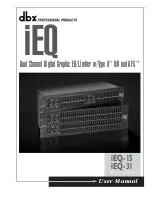
7
or maximum signal level. During operation the switch should
be in the MAX position, indicating the maximum signal level
of all possible overload points inside the unit. Time con-
stants are chosen for easy read-out and comfortable ad-
justment of the DYN control.
The INPUT and OUT positions enable overall gain adjust-
ment of the unit and should only be used temporarily while
adjusting the equaliser. Response time of the display is
very fast in this mode to avoid delay.
12.
Headroom meter and a clip indicator. The headroom indi-
cator is an average calibrated peak meter that indicates
headroom in dB from clipping level. The clip led lights at
+20dBu (0 dBu is 0.7746V). The absolute overload point of
the unit is at +21dBu. The clip led gives accurate indication
of overload conditions inside the unit, independent of the
measuring point switch position.
13.
Bypass All switch with control led to bypass the complete
equaliser. By pressing this knob, the input is directly linked
to the output by means of a the fail-safe relay. When the
power to the unit is removed, the unit automatically switches
to this bypass mode.
14.
Dynamics control knob. This control enables levelling of
the signal inside the equaliser. By turning the control anti-
clockwise (low noise position) the signal is amplified at the
input and attenuated at the output. This increases the sig-
nal level in the equaliser electronic circuits and improves
the signal to noise ratio by as much as 12dB. Use the head-
room indicator as a read-out of the maximum signal level in
the units circuits to adjust this control.
Turning the DYN control clockwise will reduce the input gain
and at the same time increase output gain, to keep overall
gain constant. As a consequence, the input signal level to
the filters is lowered, giving more headroom at the expense
of an increased noise floor. Because the headroom indica-
tor measures signal level at every critical point in the equal-
iser, therefore also at the output, turning the DYN control
clockwise will not always show up on the headroom indica-
tor. Reason is that the output level remains the same and
decreasing the signal level in circuits that precede the out-
put is not sensed by the headroom indicator.
The true virtue of the clockwise DYN range becomes ap-
parent when some filters in the unit are masked by others.
For instance, when the shelving controls are used to boost
a range of frequencies while the graphic equaliser is used
to cut a specific range of these frequencies. In such case it
can be important to reduce the signal level in the shelving
filters to accommodate the boost and avoid clipping of the
these filters. In this case the gain in headroom is clearly
indicated by the level meter because the measuring point at
the shelving filters in not masked by the output measuring
point because the graphic equaliser that follows the shelv-
ing filters in the signal path, attenuates the output level.
Changing the DYN control position does not change overall
gain of the unit (smaller than ±0.5dB of overall gain change
over the entire control range).
15.
Gain control knob to adjust overall gain between -12dB
and +12dB. 16. Four M4 screws fix the 19" bracket orna-
mental parts. In case a security cover is mounted, these
mounting positions are used to fix the security cover.
* Note:
Although high quality carbon polymer potentiometers
are used in this unit, absolute calibration accuracy of these
controls is only modest. Indicated values on the front panel
represent average numbers collected from several produc-
tion lots. Actual values can differ by as much as 20% from
the indicated values.
Содержание GE134
Страница 2: ...2 ...































